A quintessential Malaysian favorite. Nasi Lemak features fragrant and rich coconut rice with spicy sambal, topped with crispy anchovies, crunchy peanuts, hard-boiled egg, and cool cucumber.

Nasi Lemak has been dubbed the national dish of Malaysia! It is a popular breakfast item but can be enjoyed at any time of the day.
Nasi Lemak can be served with a variety of different toppings, but the traditional Malaysian version features fragrant and rich coconut rice with a spicy sambal, topped with crispy anchovies, crunchy peanuts, hard-boiled eggs, and sliced cool cucumber.
A fantastic blend of sweet, spicy and savory.
Growing up in Malaysia, one of my fondest childhood memories was buying Nasi Lemak wrapped in banana leaf from our school canteen. This is a dish that I craved very often while I was living abroad.
Making Nasi Lemak at home is easy but can be quite time-consuming. I promise that it is worth the wait!
As there are quite a few components to making Nasi Lemak from scratch, I have written a recommended preparation sequence at the bottom of this post if you are planning to make this dish in just one day.
Fortunately, all of the prepared ingredients for Nasi Lemak keep quite well, so you may certainly prepare some ingredients ahead of time.
How to Make Nasi Lemak on your Stovetop
If you have cooked white rice on a stovetop before, you will notice that cooking Nasi Lemak uses the same technique with just a few additional ingredients.
Pour 2 cups of uncooked white rice into a pot. Rinse three to four times or until the water is less murky.
Pour ½ cup coconut milk and 2 ½ cups of water over the rice.
Tie 2 pandan (screwpine) leaves into a knot, and add it to the pot. If you are not able to find fresh pandan leaves, you should be able to get frozen pandan leaves at your local Asian supermarket.
Add 1 knob of ginger (peeled; approximately 1 - 2 inches), and 1 teaspoon of salt to the pot.
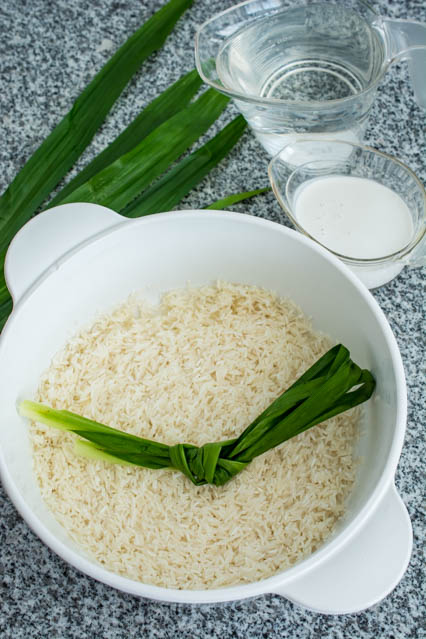
Place the pot on the stove over high heat to bring it to a boil (uncovered).
When it is at a rolling boil, reduce the heat to medium to bring it down to a simmer.
After a while, most of the water would have been absorbed by the rice or evaporated. When you can see that the water has absorbed just past the surface of the rice (as shown in the picture below) and little “craters” have formed on the rice surface, place the lid on the pot.
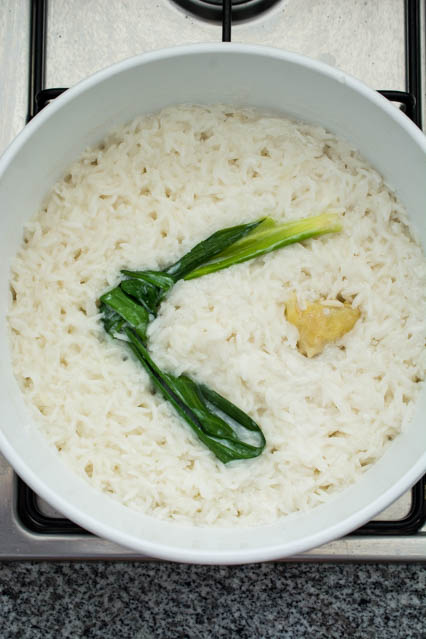
Allow it to boil for a few more seconds with the lid on, then turn OFF the heat.
Leave the lid on to allow the rice to cook. NO PEEKING!! The rice will be done in approximately 15 minutes.
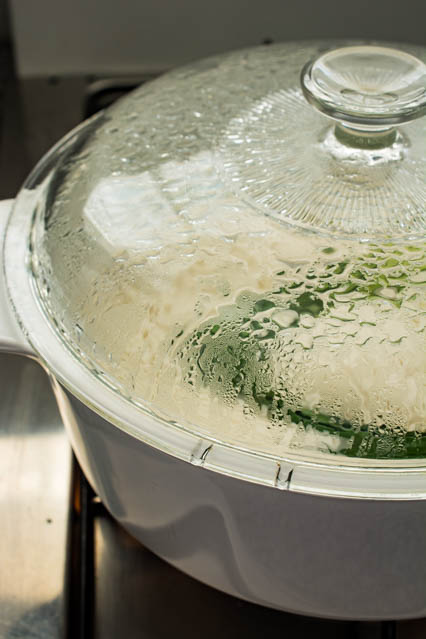
When the rice is cooked, open the lid, then pour another ½ cup of coconut milk over the rice.
This additional coconut milk will add a ton more flavor, richness, and creaminess to the rice. You may omit this step if you prefer a more subtle coconut flavor and lighter texture in the rice.

Sprinkle 1 tablespoon of sugar over the rice. Stir well, then place the lid back on the pot for about 5 more minutes before serving.

How to Make Nasi Lemak in a Rice Cooker
Making Nasi Lemak in a rice cooker is super convenient and easy!
If you have a rice cooker and wish to use that instead of cooking the Nasi Lemak over your stovetop, here are the steps to follow.
- Wash and rinse two cups of uncooked white rice in the rice cooker pot 3 - 4 times or until the water is less murky. Drain as much of the water as possible, then add ½ cup of coconut milk.
- Fill the pot to the "2 cup" line with water.
- Tie 2 pandan (screwpine leaves) leaves into a knot, then add it to the rice cooker pot. Add 1 knob of ginger (peeled; approximately 1 - 2 inches), and 1 teaspoon of salt.
- Turn on the rice cooker.
- As soon as the rice cooker switches to "warm" mode or turns off (when the rice is cooked), open the lid, and pour an additional ½ cup of coconut milk, and 1 tablespoon of sugar over the rice. Stir well.
- Put the lid back on and let the rice sit for about 5 more minutes before serving.
How to Make Sambal for Nasi Lemak
Nasi Lemak is quite versatile so you can also serve it with other spicy sauces/dishes such as Rendang or Ayam Masak Merah.
Side note: Nasi Lemak (just the rice) also pairs extremely well with Tamarind Shrimp!
Would you like to save this?
Here is a very basic Nasi Lemak Sambal recipe:
Rinse, then soak 10 - 15 pieces of dried red chili for about 15 minutes. You may wish to remove the seeds from the chilis to reduce the spiciness level of the sambal.
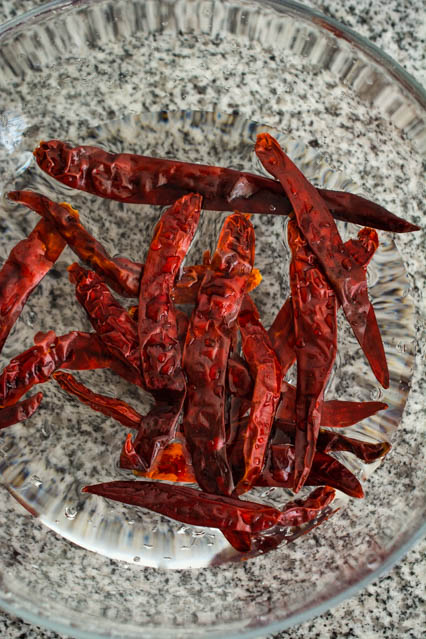
Soak 1 tablespoon of tamarind paste in 1 ½ cups of warm water.

Place the drained chilies, 2 small shallots, 2 cloves of garlic in a food processor.
If you have access to it, you may also add 1 teaspoon of belacan. This is optional but highly recommended!
Use your fingers to gently press the tamarind pulp to release the tamarind juice. Pour the tamarind water into the food processor through a sieve. Use a small spoon to press as much of the juice as possible from the tamarind pulp. Discard the pulp.
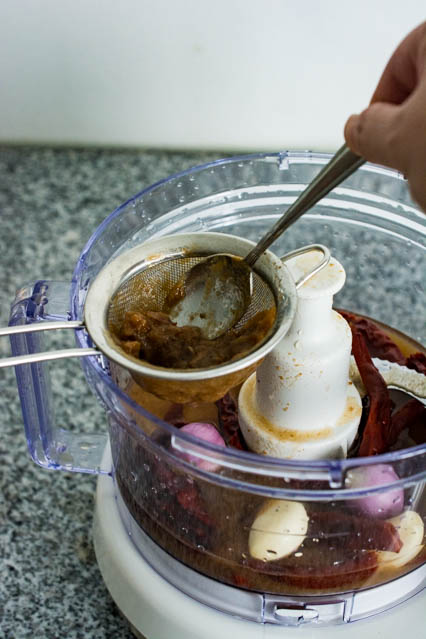
Blend the sambal ingredients to a puree.
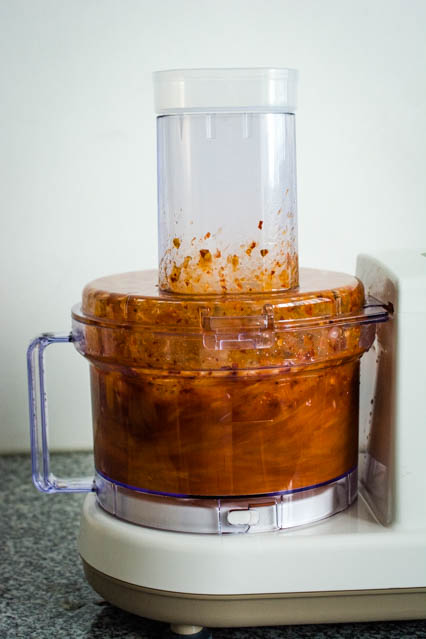
Heat 2 tablespoons of cooking oil in a wok over medium heat.
Add ½ an onion (sliced) to the wok, and sauté until soft.
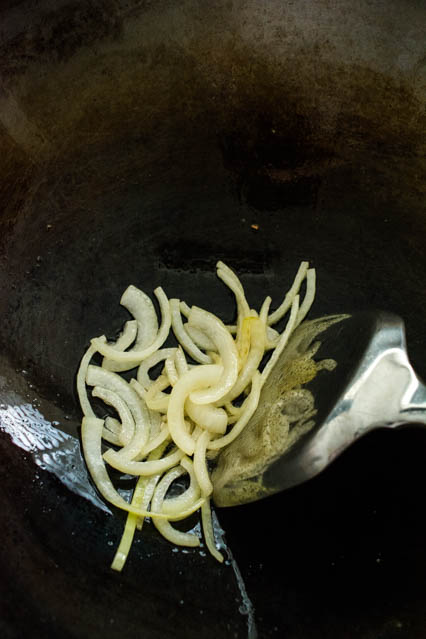
Add all of the sambal puree to the wok, followed by 1 tablespoon of brown sugar.
Give the sambal a stir, then do a quick taste test. Add more sugar and/or salt to your taste. If the sambal is very spicy, add more sugar to balance the flavors.
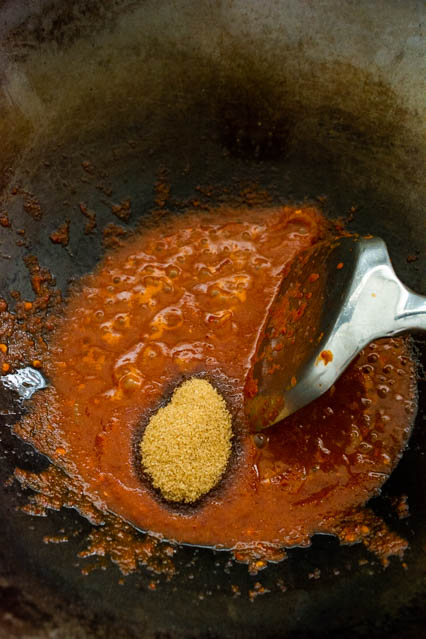
Allow the sambal to simmer until it has thickened. This will take several minutes.
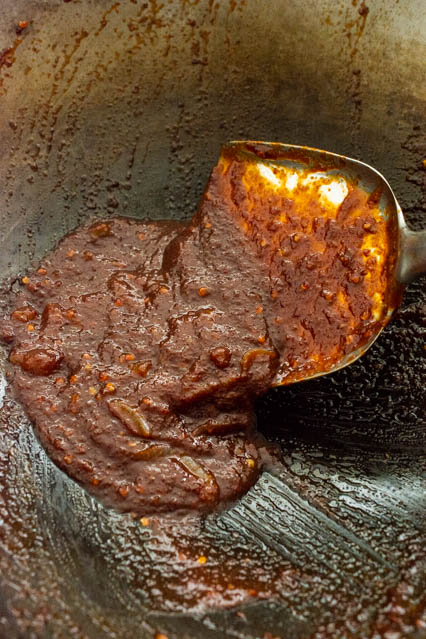
Other Nasi Lemak Ingredients
The Malaysian Traditional Nasi Lemak is typically served with sliced cucumbers, hard-boiled egg, peanuts and crispy anchovies (ikan bilis).
You could use plain roasted salted peanuts, but I highly recommend frying your own raw red skin peanuts. Add enough oil to your wok to deep-fry the peanuts. Fry them for just a few minutes, then remove them from the wok using a spider skimmer, then place the peanuts on paper towels or newspaper. Sprinkle salt over the peanuts.
To prepare the crispy anchovies, simply deep fry approximately 1 cup of dried anchovies. You can find dried anchovies in most Asian supermarkets. I would recommend the small to medium-sized anchovies. Use a spider skimmer to remove the anchovies from the oil when done.
Top your Nasi Lemak with crispy shallots if desired.

Nasi Lemak Preparation Sequence
There are so many components to cooking nasi lemak so it is very helpful to have a plan or sequence in place. Knowing exactly what to do will minimize the time you spend in the kitchen, as well as your stress level!
I've listed my recommended sequence below if you are preparing Nasi Lemak in just one day:
- Rice: Wash and prepare rice, set on stove/in rice cooker.
- Hard-boiled eggs: Place eggs in a small pot, cover with water, set on stove to boil.
- Soak dried red chilies and tamarind (in separate bowls).
- Remove skin from 2 shallots and 2 cloves garlic. Slice 2 more shallots and 1 onion.
- Heat up oil in wok for deep-frying.
- Eggs: If water for eggs is boiling, turn off your stove, but keep the eggs in the hot water so they continue to cook.
- Rice: if cooking the rice on your stovetop, cover when ready (continue these steps below, keep checking on rice if not ready yet).
- Deep-fry peanuts. Add salt to peanuts. Deep-fry shallots.
- Deep-fry anchovies.
- Sambal: Place all sambal ingredients into food processor. Blend.
- Remove oil from wok (leave about 2 tablespoons).
- Cook sambal in wok.
- Rice: Add coconut milk and sugar. Kep covered.
- Slice cucumber, cut hard-boiled eggs in half.
- Ready to serve!
If you have a few days to prepare the Nasi Lemak, you may certainly prepare some of these ingredients ahead of time. The sambal and hard-boiled eggs will keep in the fridge for up to a week.
You may store the peanuts in an air-tight container in the fridge for up to a month or at room temperature for up to two weeks.
If you're like me and love your ikan bilis (anchovies) really crispy, I would highly recommend them frying them the same day that you will be using them.
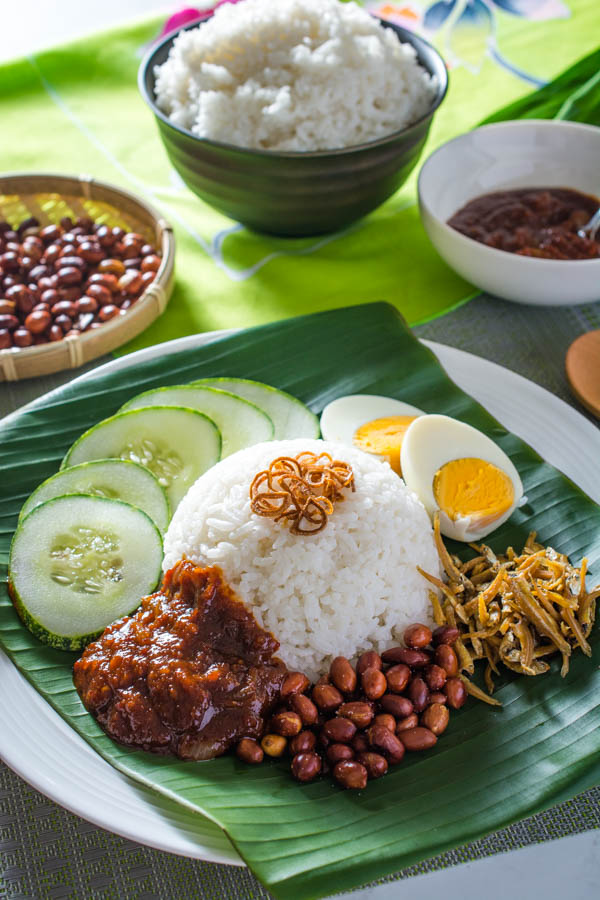
I hope that this guide to making Nasi Lemak at home has been helpful to you!
Enjoy!

Malaysian Nasi Lemak
Ingredients
Nasi Lemak (rice)
- 2 cups uncooked white rice
- 1 cup coconut milk divided
- 2 ½ cups water
- 2 pandan screwpine leaves, tied into a knot
- 1 knob ginger 1-2 inches
- 1 teaspoon salt
- 1 tablespoon sugar
Sambal
- 10 - 15 dried red chili
- 1 tablespoon tamarind paste
- 2 shallots
- 2 cloves garlic
- 1 teaspoon belacan optional
- 2 tablespoons cooking oil
- ½ onion sliced
- 1 tablespoon brown sugar
Other ingredients for Nasi Lemak
- 2 eggs hard-boiled (halved)
- ½ cucumber sliced
- 1 cup raw red skin peanuts
- ½ teaspoon salt
- 1 cup dried anchovies
- ¼ cup crispy shallots for garnish optional
- cooking oil for deep-frying
Instructions
Nasi Lemak (rice)
- Rinse the rice 3 - 4 times or until the water is less murky.
- Pour ½ cup coconut milk over the rice.
- Add pandan leaves, ginger and salt to the pot.
- Place the pot on the stove over high heat to bring it to a boil (uncovered).
- When it is at a rolling boil, reduce the heat to medium to bring it down to a simmer.
- When you can see that the water has absorbed just past the surface of the rice and little “craters” have formed on the rice surface, place the lid on the pot.
- Allow it to boil for a few more seconds with the lid on, then turn off the heat.
- Leave the lid on to allow the rice to continue to cook for about 15 minutes. No peeking!
- Pour the remaining ½ cup of coconut milk and sugar over the rice. Mix well, then cover the pot again.
Sambal
- Remove the seeds from the dried red chili. Rinse, then soak the chilies for about 15 minutes.
- Soak the tamarind paste in 1 ½ cups of warm water for 15 minutes.
- Place the drained chilies, shallots, garlic and belacan (if using) in a food processor.
- Use your fingers to gently press the tamarind pulp to release the tamarind juice. Pour the tamarind water into the food processor through a sieve. Use a small spoon to press as much of the juice as possible from the tamarind pulp. Discard the pulp.
- Blend the sambal ingredients to a puree.
- Heat cooking oil in a wok over medium heat. Sauté onions until soft.
- Add the sambal puree to the wok, followed by brown sugar.
- Do a quick taste test. If too spicy, add more sugar.
- Allow the sambal to simmer until it has thickened. This will take several minutes.
Fried Peanuts:
- Heat up cooking oil for deep-frying.
- When the oil is hot, add peanuts.
- Allow the peanuts to fry for about 2 minutes, then remove them from the wok using a spider skimmer. Place the peanuts on paper towels or newspaper.
- Sprinkle salt over the peanuts.
Crispy anchovies:
- Deep fry the dried anchovies for about 2 minutes or until crispy. They should be a very light golden brown color.
- Remove the fried anchovies from the wok using a spider skimmer.
- Spread the crispy anchovies over paper towels or newspaper.



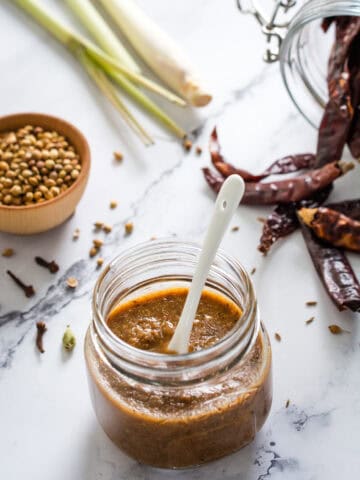


Sharmila says
Hi Charmaine, Looking for the Lemak ratio for the rice today and found you!!! Blessings!
Char says
Hi Sharmila!!! What a nice surprise! 🙂 I'm so glad you found this recipe. I hope you enjoy it. Take care!